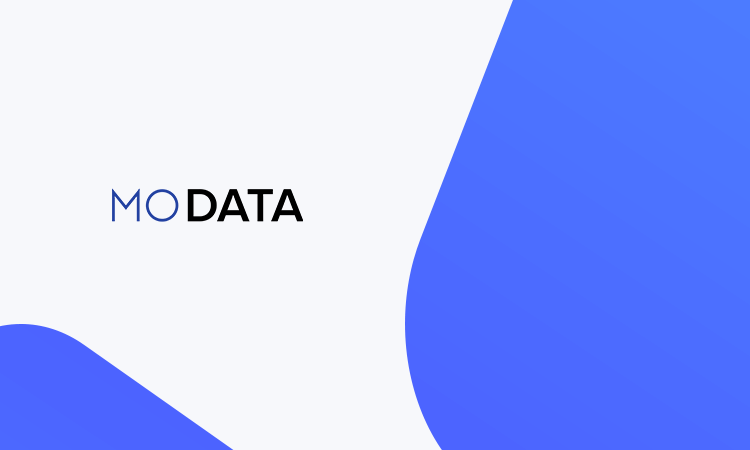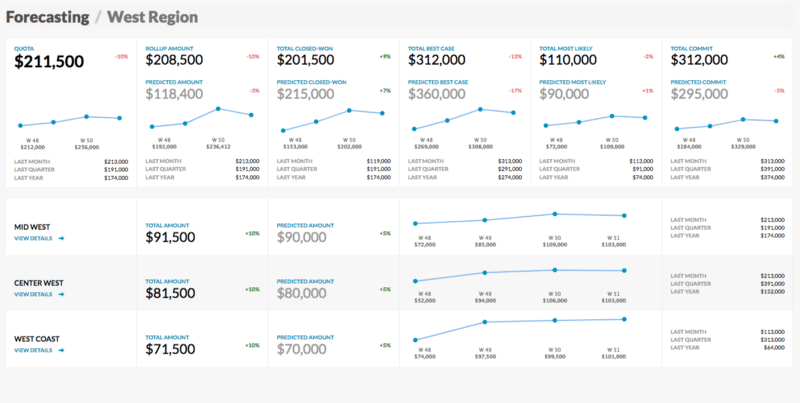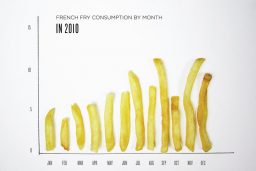
“If you have to forecast, forecast often.”
— Edgar Fiedler
Sales forecasting is one of the essential components of business success. It can be the difference between meeting your quarterly targets and falling short of achieving your goals. However, creating an accurate sales forecast is not easy. It requires institutional discipline, time investment and organizational buy in. Besides, everybody in sales is typically super focused on delivering on current plans and its not easy to persuade them to look into future. This is the reason most sales ops managers find it hard to spend time forecasting and some don’t even try it.
By the end of this article, we hope to explain:
- What is a sales forecasting?
- Why is sales forecasting important?
- What factors influence sales forecast?
- What do you need for an accurate sales forecast?
- Sales forecasting methods
1. What is Sales Forecast?
“Sales forecast” is a future estimate of a team’s, department’s, or even a company’s sales performance over a set period of time.
It is generally influenced by several different factors, which can determine the validity of the prediction. More on this later in the article.
The most common sales forecasting modelling technique follows “bottoms up” approach. With “bottoms-up” approach Reps’ individual performance estimate is used to determine the performance of the team. Then the directors use the teams’ sales forecasts to make predictions about their individual departments. At the top, the Sales VP uses the provided information to estimate the performance of the entire company.
By starting at the bottom level, Management can easily see the emerging trends. This allows Management to identify potential problems and negative tendencies in advance. It is tremendously helpful when trying to stay ahead of the curve in terms of hiring and setting expectations of rest of the executive team. Accurate sales projection increase the chances of hitting the period’s quota, by aligning the whole company including marketing, product development and customer success behind a single goal. It can also help with increased business development and eventual revenue growth.
Purpose
Sales predictions can be used for a variety of different reasons. They are incredibly useful for business owners, sales managers, and investors alike.
Planning and Targets
Managers need to set realistic targets. They can use sales projection calculations to set proper goals for salespeople. Tangible objectives are productive for both managers and employees. Managers can follow the progress and notice early on if someone is falling short. On the other hand, salespeople have a clear goal to strive for, which is not always the case if there is no sales forecast.
Companies can also decide whether they have enough people to meet projected demand or start hiring early on. If estimates show inability to handle all incoming business, then managers can start hiring people promptly before the problem starts, instead of doing it when its already too late. This is especially important if newcomers need training, very common problem in most B2B companies.
Funding and Financials
Sales forecasting is often used when making financial decisions related to the organization. Readiness to meet a potential surge in demand may not be possible without proper forecasting. If projections show an increase in business the following season, the head of the company may be advised to look for additional investors or to take a loan in order to fund the estimated business growth.
Investors often require sales projections in order to make up their mind about whether to invest money on a certain business. Based on this data, they try to get a rough estimate of their ROI. A positive & upward trending projected sales metrics can be quite beneficial for attracting more outside capital.
Creditors utilize sales predictions, as well. They use them to determine an organization’s ability to cover their debt. It is a good sign if the requested loan and projections are in line. While, it is not the only parameter they use, sales projections are quite important nevertheless.
Benchmarking and Risk Assessment
Projected sales numbers can also be used to evaluate the organization’s expected performance as compared to rivals. This allows for some foresight and early measures that may end up mitigating potential losses.
Sales forecasting help with risk assessment. If, for example, sales are expected to be low during a certain time period, then taking a loan would be risky and ill-advised. Because it’s usually based on data, sales forecasting is critical for making more informed decisions, help an organization avoid taking chances.
Sales Forecasting Objectives
Not all sales forecasts are created equal. Various factor influence the effectiveness of a sales forecast. In this section we have compiled a few factors, which play a key role. To ensure reliability of your sales forecast, its advisable to pay attention to all of them and get them right.
Accuracy
The first and foremost component of a good sales forecast is accuracy. It’s easy to to see how a sale forecast not rooted in accurate data is not going to be very useful and is unlikely to to accomplish its desired goal.
It is however, not obvious, that in a complex & fast paced world of sales its very easy not to have right numbers in your CRM (or whatever other mechanism you use to track your deals). There are many reasons for this to happen
- Outdated deal amount: While it might be common knowledge within a certain number of people like the sales rep and his manager its very common for the sales reps to not update the CRM with new dollar amount for one or more deals. They know it just haven’t gotten around to update it.
- Opportunity Stage Paradox: Sales reps tend to live on extremes, they are either very optimistic or super pessimistic. While, a typical sale funnel tends to have 4–5 stages most reps add most of the deals in first stage and leave them there till they are very confident about the deal. When they are confident about the deal they then move it quickly to the last (pre-close) stage.
- Time to close: This is specially true for a high velocity businesses (be sure to read our upcoming article specifically about high velocity sales), where deals move up and down the funnel relatively quickly. Its not uncommon for CRMs to misrepresent “expected close date” beyond current quarter. Sales rep would typically push deals to some random future quarter.
- Missing Deals: Sales rep would typically miss adding any opportunities, not originating from marketing generated leads, to the CRM. These opportunities typically involve upsell/cross-sell opportunities with current customers, referrals from customers and opportunities sources directly by sales rep through her own network.
Sophisticated sales forecast software can be quite helpful to fill this gap. Such software allows sales managers who are generally quite knowledgeable about each sales reps pipeline to override bottom up estimates. This allows them to not only participate in the sales forecasting process but also add tremendous value by filling the gap left because of the issues described above.
Some of these software packages also use historic data along with Machine Learning and Artificial Intelligence, in order to predict future trends. Hence, allowing for a more data-driven / prediction based approach which along with bottoms up approach described above gets you closer to a more accurate & comprehensive sales forecast.
Its important to note that, although it’s a powerful base, historic data alone is not enough. Other factors also need to be taken into consideration, such as competition changes, technological advancements, market shifts, client needs, reps performance, etc. Hence the forecasts which rely very heavily historical trends often tend to miss the mark.
Micro-Trends
An increase or decrease in sales doesn’t tell you much in and of itself. However, a sales forecasting process need to evaluate such increases and decreases which are reoccur in a cyclic ways. If the sales of a certain item always unexpectedly drop on a regular basis, you want to consider it in your sales forecasting process. Even if you’re doing well overall and that item does not form a bit proportion of your sales keeping track of such micro-trends is critical in the long run. Try to always see the forest, but also keep an eye on those trees.
Timeline
Estimated sales figures should include establishing a timeline for such forecast. No forecast is valid indefinitely. It expires. With passing time, new realities emerge and have to taken into account. While, the nature of almost every sales process is typically cyclic, those cycles often get disrupted by new market dynamics. For example, if your sales numbers for a particular product has been going up historically, but you now have a new competitor and they’re doing well on a certain market. Future forecasts need to consider these new realities.
Establishing a timeline would also play a crucial role in resource allocation. Timeline provides a clear demarcation in which the assumptions (behind the sales forecast and hence the execution strategy / direction) don’t need be reevaluated. Timeline provides the confidence required to ace sales goals. It’s also useful in aligning sales and marketing together.
Sales Support Infrastructure
An accurate sales forecast needs to capture resources required to support a certain deal flow. From marketing & sales enablement to sales operations, a whole host of resources are required to deliver on forecast. Any forecast which does not take into account organizational ability to provide sales infrastructure in terms of enabling tools and hiring sales support staff is unlikely to turn out accurate.
2. Why is Sales Forecasting Important?
Sales forecasts are a fantastic tool to guide important business decisions. The importance of this data-driven process goes beyond that.
Making cash flow decisions
Managers and high-level executives often take sales forecasts into consideration when making critical cash flow decisions. If the data proves to be wrong, this can put the organization in serious trouble. This serves not only to highlight how important this type of projection is. It also stand to show how crucial accurate data has become. Luckily, sales forecasting software has made some significant advancements in recent years and has become incredibly reliable.
Cleaning up the pipeline
Sales managers can remove weak leads from the pipeline and avoid sending the reps on a wild goose chase. This optimizes the process and allows salespeople to focus on those leads that are likely to close.It improves both conversation rates and team morale.
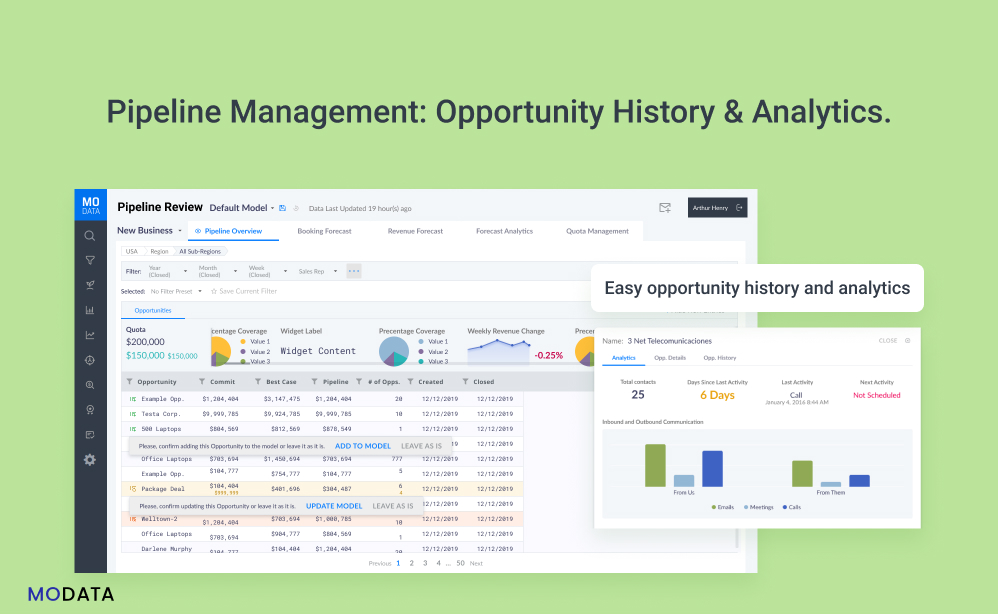
Sales prioritization
Removing weak leads from the pipeline is just one step. A sales manager can also direct reps at high priority leads. Based on the data, certain deals will be more likely to close than others. Armed with this information, sales reps are able to delegate their time and resources more efficiently, resulting in an even further increase in conversions and revenue. Everyone in sales team get a sense of shared purpose and common direction
3. What Factors Influence Sales Forecast?
There are several factors that can influence a sales prediction. They can be broadly put into two categories — external and internal.
External factors
Product changes
An upgrade to your product and introduction of new features are closely related to sales and sales projections. Removing a bug or an undesired feature may lead to lots of new business. Conversely, introducing undesired features and allowing buggy software to be released can lead to customer complaints finally precipitating into notable losses.
Seasonality
The time of the year may have an effect on your sales. For example, the holidays are a time when many product sales rise due to increase in consumer demand. However, at the same time the need for many services drops, so those sales tend to suffer. Some products and services are even more dependent on the season.
Economy
The economy having a huge impact on business is a no-brainer. When the economy is strong, people feel more secure and are more likely to spend. Deals close more easily. This increases sales.
When there are economic shifts, people tend to become more conservative. They scrutinize deals a lot more, which reduces the rates and chances for closure. This decreases sales. The state of the economy needs to be taken into consideration.
Legislative changes
Many people don’t particularly care about politics. However, for a business owner or a sales manager is a mistake not to. Legislative changes may have a huge impact on a business, both positive and negative. It’s erroneous to prepare a sales forecast without taking such changes into consideration.
Industry changes
Changes in the industry can have a dramatic effect on a sales forecast. Going up against a new competitor or an old one who has upgraded their product will definitely affect sales numbers. Consequently, someone else launching a product that complements your can have a positive effect on both businesses.
A sophisticated and date driven sales forecasting software allows you to perform sensitivity analysis thus allowing you to account for such external factors
Internal factors
Policy changes
Policy changes are another huge reason why your sales forecast may be affected. It can have a dramatic impact on employee motivation, close rates, number of customers, and more.
For example, if you were previously offering a discount which you decide to terminate, you can expect the number of closed deals to decrease, while the profit from every deal to increase. Both need to be taken into consideration for the projected numbers.
Human resources
The human factor always has some kind of bearing on projections. Whether your number of employees increases or decreases, that usually indicates some changes in revenue. If you hire a large number of new employees, then a surge in revenue is expected.
Also, if you change your salespeople often, that can negatively impact your revenue. It takes time before a new employee can actually be useful. Alternatively, if you offer multiple services and let everyone do everything, that also has an impact. Your salespeople become jack of all trades, master of none. Specialization usually has a positive effect on sales.
A sophisticated sales forecasting software automatically calculates sales rep ramp up time (based on heuristics data from the past) and allows you to use that information during forecasting.
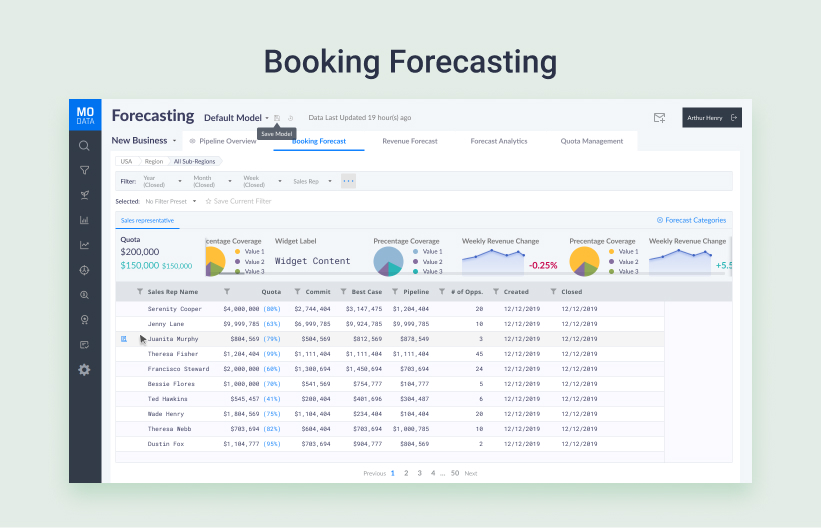
4. What Do You Need for an Accurate Sales Forecast?
In order to get an accurate prediction, you require several essential elements.
Performance measurements
You need to measure performance before you can predict it. Objective measurements at the personal and team level will help you convey to your team where they stand. It will also assist in creating realistic targets for them to complete. This is an integral component of a sales forecast.
CRM Hygiene
You would need to ensure that your CRM reflects accurate state of deals. As mentioned earlier many organizations struggle with one or more of following issues.
- Outdated deal amount
- Opportunity Stage Paradox
- Inaccurate Time to close
- Missing Deals
To ensure proper hygiene one must implement process and automation to “nip the problem the bud” before they become a big issue.
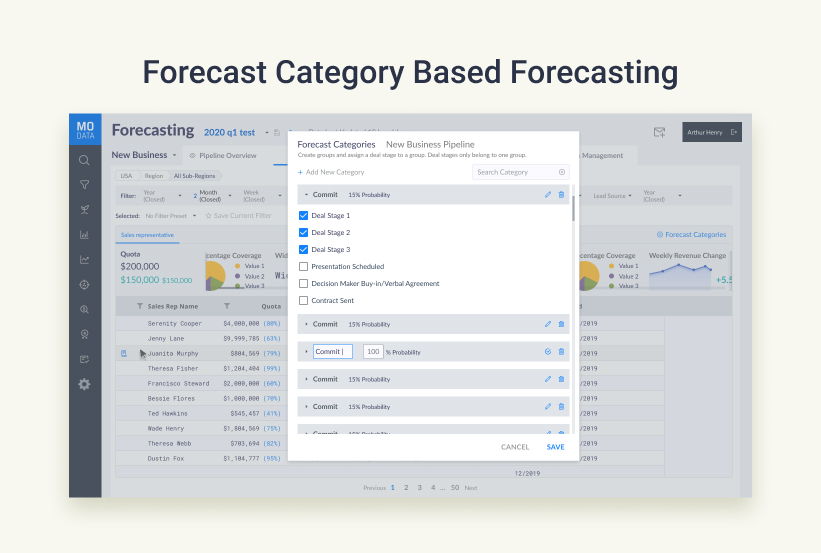
Organized Sales Process
All sales reps must conform to the same process in order to get accurate measurement. They are to have an agreement about the stages of the process so that they can measure them in the same way. Otherwise, data would be unreliable.
Historical Data
Historic data is one of the main predictors of future performance. This is especially true when there aren’t any changes in other variables. It’s a good idea to always take it into consideration, but for that you need to record it, first.
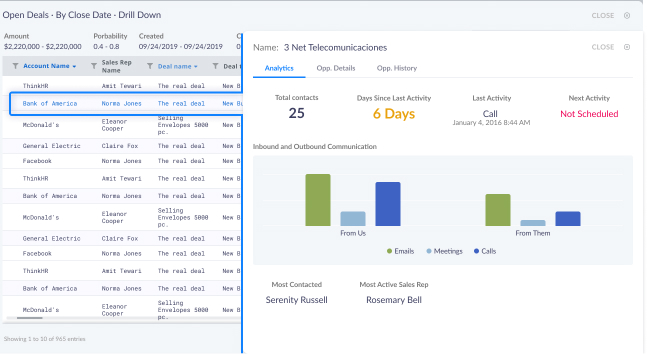
Software
CRM is still one of the most popular models, though it’s quickly becoming obsolete with the advent of machine learning and AI powered sales intelligence. This allows you to make sense of the data much more easily.
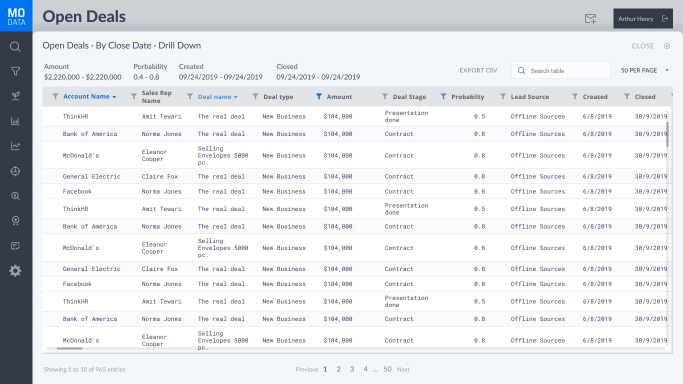
5. Sales Forecasting Methods
There is more than one way to establish sales projections. Some are more data-oriented, and some rely on intuition. Depending on different factors, all of them are useful in one situation or another.
Intuitive Sales Forecast
Intuitive forecasting is based on the salespeople’s estimates. This allows them to fall back on their own experience and knowledge of the pipeline. They are the people, who are in close proximity to the prospects, so their approximation can be fairly accurate.
For this method to work sales reps need to have pretty good understanding of customers buying journey, their process, sentiment and budget allocation. Deep level of knowledge about so many factors requires time and high level of engagement with the customer. Hence this method is suitable when each sales rep / account executive is working with relatively fewer number of accounts.
The downside to this method is that salespeople are often fairly optimistic. This means their forecasts are rather generous, which should be taken into account. As a side effect, intuitive forecasting isn’t overly accurate. However, it’s adequate enough when you don’t have enough data to use some of the other methodologies.
Conversely, in some situations where deal sizes are large i.e. multiple-million dollars or more, its often the only method feasible to project sales.
Historical Sales Forecast
Sales Forecast = (Last period’s Sale ) X (Percentage Growth Estimation)
It’s more of a brute force push instead of a real estimation or projection. A top-down (vs bottoms up), aspirational target. A self-fulling prophecy in a way, where the sales team pushes to make the target because well that’s the target.
This method can also be quite unreliable, despite the fact it is based on data. It doesn’t take any other factors into account. Market changes, competitors, consumer intent, industry conditions — none of this makes the cut.
A purely historical analysis is not going to give you an accurate estimation. Even if you take into account company growth and seasonality (which already complicates the model a lot more), there are many different factors you’re not taking into consideration. However, if you need a quick and easy forecast, this is the best method in terms of speed.
Opportunity Stage Based Forecast
This method takes the stage in which a certain deal is at the moment as the basis for the likelihood it will close. The further down the pipeline a deal is, the higher the chances of coming to a successful completion. The pipeline is divided in multiple ( usually 3–7) stages. Sales reps assign each deal they are working on to a particular stage. Companies establish a fairly tight qualification criteria which needs to be met before a deal can be deemed associated with a particular stage. Each stage has a percentage closure probability associated with it, based on the criteria used to define the stage.
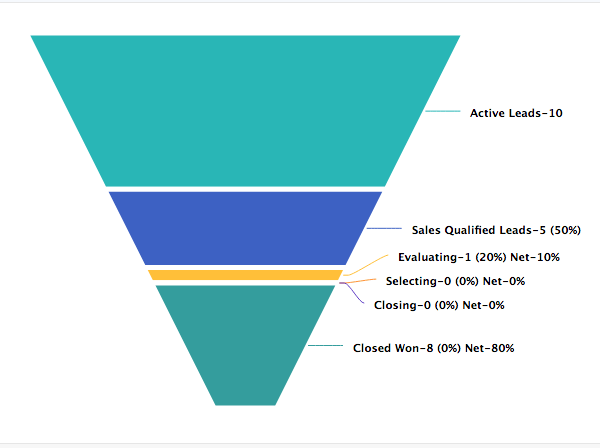
So, you know the probability of a certain deal closing based on stage it belongs to. You multiply the deal amount by the probability of success. You do this for all deals and take the sum as your overall sales projection.
Sales Forecast = Sum ( Deal Amount X Deal Stage Probability)
This is a really easy method to make a forecast. The downside is that it may not be very accurate, because
- It’s highly dependent on your sales people cleaning up their pipelines in terms of associating each deal with most appropriate opportunity stage.
- Another main issue here is that this method doesn’t take “time” factor into consideration. If a deal is going through the stages quickly, there is a much higher chance of it being completed successfully. On the other hand, if it’s been sitting at a certain stage in the pipeline for months, the chances of closing it are very slim.
- Deal amount also tends to be a fairly random guess till the deal is much further down i.e. close to the neck of the funnel. In a funnel model a majority of deals, by definition, sit on top of the funnel. If the amounts associated with such deals are off by a lot they tend of have a uneven cumulative effect on over all forecast because of sheer number of such deals.
Forecast-Category Based Forecast
This method is very similar to opportunity stage forecast as described above. Instead of using opportunity stage to describe probability of closure estimates by reps another field called “Forecast Category” is used to collect the feedback from reps and their managers. Common forecast categories used include
- “Commit” : Sales rep is committing that deal will close unless something goes wrong.
- “Best Case”: Deal would likely close if a few things go our way.
- “Pipeline”: Deal have positive momentum, it would go our way but it may not happen this quarter / time period. It may but many things would have to align for that to happen.
Sales Forecast (Commit )= Sum ( Deal Amount X 90%)….. (S.1)
Sales Forecast (Best Case)= Sum ( Deal Amount X 30%)…..(S.2)
Sales Forecast (Pipeline)= Sum ( Deal Amount X 10%)……(S.3)
Sales Forecast = Sum ( S.1 + S.2 +S.3 )
This technique is usually followed when:
- Opportunity stages need to be reserved for tracking activities and other operational purposes
- Sales manager’s assessment needs to be collected on top of sales reps assessment for each deal. Sales managers typically do not move deal from one opportunity stage to other but use “forecast category” to express their assessment.
While similar to opportunity stage forecasting this method does not take into account time per stage for the deal, it tends to be more accurate, because it takes into account sales manager’s assessment on top of reps assessment.
Sales Cycle Length Based Forecast
In order for this method to work, you need to take the length of your sales cycle into consideration, as well as how long ago the lead came in.The more time has passed for a deal in the same cycle, the bigger the chances for closure.
This prevents overt optimism. If it’s too soon in the sales cycle, yet the salesperson is positive the client is ready to buy, the time period will be taken into consideration. This way you won’t artificially inflate the forecast.
The downside is that, like other simple methods, it only takes one factor into consideration. This is not a good idea for something so complex as a sales forecast. If you’re going to use specialized software, you might as well put it to good use.
Multi-Factor Sales Projection / Forecast
The highlight of sales forecasting is the multi-factor sales projection. It’s the most advanced method you can use. It is a bit complicated and requires the consideration of several factors. As such, you need a lot more data, but this also makes it far more accurate.
A multi-factor sales projection takes the average length of the cycle, historical data, rep performance, and stage to create a complete forecast. In many ways, it bypasses the drawbacks of all the other methods and compensates for their weaknesses. This makes it the most recommended sales projection tool available.
That being said, it still requires quite a bit of data and sophisticated software. It’s also much slower, which isn’t necessarily a bad thing, but it work if you need a projection fast. Also, because it requires so much data, it’s not a good fit for businesses that are just starting out.
Given the size of data and complexity involved, this method is most suitable to be used in conjunction with modern Machine Learning and Artificial Intelligence Algorithms. One must be careful to ensure human feedback is part of any such machine learning exercise else it’s common to see this technique turn into very unreliable results.
For more information about MoData offerings click here
